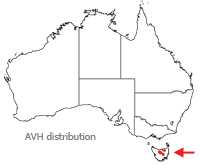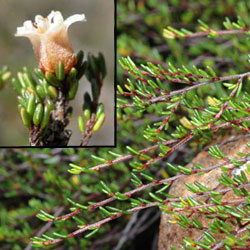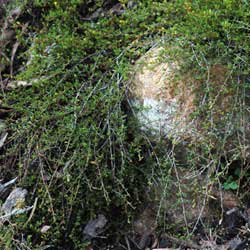Cryptandra alpina
Alpine Pearlflower
Cryptandra alpina , commonly known as alpine pearlflower, is from the family Rhamnaceae. The Rhamnaceae family consists of 58 genera worldwide, including 18 Australian genera. Cryptandra is an endemic Australian genus, consisting of 40 species.
Cryptandra alpina is a small, prostrate, woody plant that grows up to 20cm high, with many fine, delicate branches. It grows more or less in a sprawling manner and can cover an area of about 30cm in diameter. The tiny leaves, around 2-4mm long and 0.5mm wide, are alternate, cylindrical and stalked. Small white flowers are present on this plant between late summer to autumn. They are usually solitary at the ends of branchlets and are surrounded by brown bracts. The corolla is tubular with five white petals forming hoods over the stamens. The fruit is a capsule within the floral tube.
 Cryptandra alpina is found in the highland regions of central and western Tasmania, above 1000m altitude. Although Cryptandra alpina is considered rare and is restricted to relatively small areas, it is often locally abundant in these alpine regions. It is usually found scrambling over alpine meadows and around the base of rocks.
Cryptandra alpina is found in the highland regions of central and western Tasmania, above 1000m altitude. Although Cryptandra alpina is considered rare and is restricted to relatively small areas, it is often locally abundant in these alpine regions. It is usually found scrambling over alpine meadows and around the base of rocks.
Cryptandra alpina can make an attractive pot plant due to its relatively small size and pretty, white, star-shaped flowers. It is frost tolerant and would be excellent for places that are cool and damp. It is also a useful and ideal shrub for a sheltered rockery.
Successful propagation of this plant has been achieved from stem cuttings though the use of a rooting hormone is recommended as cuttings can sometimes be slow to strike. Interestingly, this plant develops roots at the intervals, or nodes, along its stem as it grows. Therefore, if you cut the stem just below a node it will encourage root development in the right area and ensure a greater chance of success for the plant.
During planting out a native potting mix should be used, as well as a thin layer of mulch or leaf litter on the surface to maintain a cool root zone and provide nutrients to the plant. A potting mix that contains peat would be beneficial but the use of a peat alternative (coconut husks, or peat-free mulch) is advised due to the ecological damage caused by the mining of peat from peatlands for horticultural purposes. Well-drained soil is preferable and a slow release fertilizer may be added to plants growing in pots.
This plant will require partial shade, particularly in the afternoon, if grown in hot and dry areas. It requires cool, moist conditions but will respond to regular watering throughout dry periods.
Once this plant is established in its preferred conditions, very little maintenance or care is required. There are no pests or diseases that are known to adversely affect this plant. However, it must be noted that this plant has not been widely cultivated and therefore may not have yet encountered any potential pests or pathogens. The major limitation of cultivating this plant is providing an environment that is cool and moist when most areas of Australia are hot and dry.
Text by Aaron Mulcahy (2008 Student Botanical Intern)
Name Meaning: Cryptandra alpinaCryptandra : kryptos, meaning hidden, and andros, meaning a man, collectively refers to the hidden anthers within the petals, which occur in most of the plant species in this genus. Alpina : means alpine, and refers to plants that grow in the alpine areas. |
Acknowledgements
Craig Cosgrove for horticultural information and advice.
Murray Fagg for the photos.
References
Cameron, M. (2000) A Guide to Flowers and Plants of Tasmania, 3rd Edn. New Holland Publishers Pty Ltd, Australia.
Elliot, W.R. & Jones, D.C. (1984) Encyclopedia of Australian Plants, Volume 3. Lothian Publishing Company Pty Ltd, Melbourne.
Stearn, W. (1992) Botanical Latin: History, Grammar, Syntax, Terminology and Vocabulary , 4th Edn. David and Charles, Newton Abbot, Devon.
Jordan, G. et al. (2007) Key to Tasmanian Dicots. University of Tasmania. Available at http://www.utas.edu.au/dicotkey/DicotKey/RHAMN/sCryptandra_alpina.htm [Accessed February 2 2007].
Walsh, N.G. & Entwisle, T. J. (1999) Flora of Victoria: Dicotyledons, Cornaceae to Asteraceae, Volume 4. Inkata Press, Melbourne.
Whiting, J., Roberts, T., Reeves, R., Tayler, F. & Tayler, V. (2004) Tasmania’s Natural Flora. Tasmania’s Natural Flora Committee, Tasmania.
![An Australian Government Initiative [logo]](/images/austgovt_brown_90px.gif)



